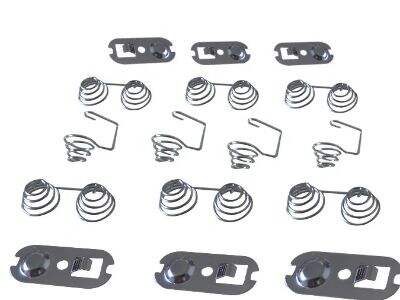In extreme heat, such as a sunny day or the location of a fire, lots of materials can change. This can also occur with compression springs, which are very critical in a lot of the machines and tools we use every day. Compression springs are little coils that compress and then spring back to their original shape. But when it gets really hot, they may not work so well. Here’s a guide to just some of the things that can count against your compression springs stretching and bouncing in the heat.
Selecting the Correct Material for Compression Springs
The material choice when it comes to a compression spring is huge when it comes to working in hot temperatures. High temperatures are better tolerated by some materials than others. When selecting the best material for a compression spring that will be used in a hot location, you need a material that can remain to be stretchy even when it becomes hot enough. Compression springs in high-temperature settings typically are made from materials, such as stainless steel, which can hold their bounce while still being able to tolerate the heat.
Heat Setting of Compression Springs
Heat-treating is akin to giving a compression spring a super power especially designed to function at elevated temperatures. By heating and cooling the spring in a careful manner, increased spring strength and better shape retention can be achieved. This treatment can have a tremendous effect on a compression spring functioning in hot conditions. A correct heat treatment can help the spring remain stretchy and bounce back even when it’s very hot.
The Impact of Heat on Compression Springs
When things heat up, they grow — much like a balloon expanding when blown up. Same goes for compression springs, in hot settings. When a spring becomes hot, it can change shape or length, and this can alter its stretchiness. Engineers have to try to anticipate how much a spring might expand when it heats up and ensure it will still work properly as temperatures climb.
Engineering Compression Springs for Heat
Designing a compression spring for a hot place is more than making it bounce. Engineers are thinking about what material and heat treatment to use, and how heat impacts the spring to ensure it remains stretchy and functions well under high temperatures. They must weigh how much weight the spring will support, how frequently it will be compressed and expanded and in what environment, to ensure it will work in the heat, for example.
Preventing Damage to Compression Springs
Rust and corrosion can be considered oxidation, which can deteriorate a compression spring, causing it to lose some bounce. These problems can be magnified when a spring is subject to high temperatures. Oxidation can make the spring’s material weaker, and corrosion can break down the integrity of the spring and lead to decreased stretchiness. To prevent such problems, however, it is crucial to rely on materials that are resistant to oxidation and corrosion, and to apply certain protective treatments that can help make the spring last longer also in hot environments.
Conclusion
If we want to keep compression springs nice and stretchy in hot environments, we need to think carefully about: the materials we choose when we're making the springs, how we heat-treat them, what degrees of heat they can handle, how we design them, and how we protect them against corrosion and oxidation. Analzying the way these things work on compression springs in heat tells engineers how to ensure these crucial parts will perform well even in the heat of the deadline. Don’t forget - HENP is here to assist with quality compression springs that can take the heat!

